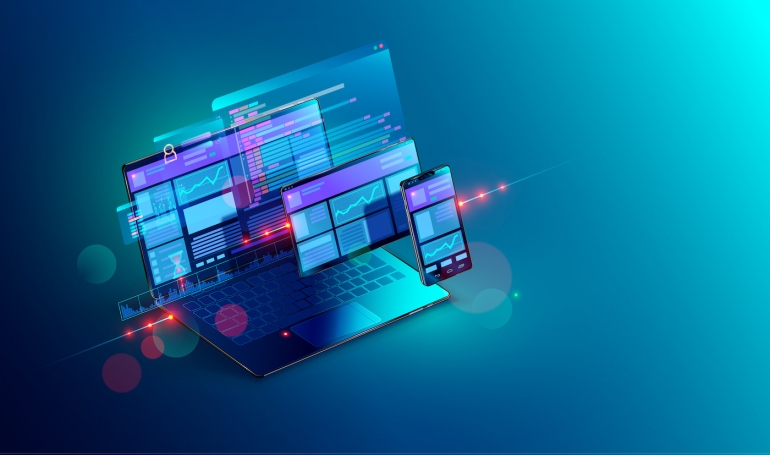This article doesn’t just provide a definition, but also looks at the benefits, drawbacks and features of SaaS.

Software as a service is a system of offering applications as services over the internet. Instead of deploying and managing software, users simply access them through the internet, freeing them from the complexities of core technology management.
SEE: Hiring Kit: Cloud Engineer (TechRepublic Premium)
Web-based technology, on-demand applications and hosted software are all synonyms used to explain SaaS applications. Irrespective of the name, SaaS applications are hosted on the servers of a SaaS provider. The provider manages application access, including confidentiality, availability and effectiveness.
Jump to:
Benefits of SaaS
Many businesses use cloud-based SaaS solutions for increased efficiency and cost-effectiveness. The benefits include:
Low setup and infrastructure costs
Users only need to pay for the services they need, with no capital expenditures that must be unnecessary for their business.
Accessible from anywhere
One simply gets an internet connection and the user can work from any location using a desktop, laptop, tablet, mobile or other networked device.
Scalability
As one’s business grows, the enterprise can adapt their requirements to the team that needs to use the technology, the volume of data and the features required.
Service level agreements level
Service level agreements are designed for uptime and performance that are unmatched in the industry. Users have the assurance that services will be available when requested, which can be difficult to guarantee in-house.
Regular, automatic updates
The scalability and feedback on what their customers require help SaaS provide timely improvements for users. This frees up the IT department to take care of more critical business tasks.
High security
Every customer expects the highest level of security from their company. Because the SaaS service is shared, all users benefit from the top-notch security level that has been set up for those who need it the most.
Disadvantages of SaaS
Though using SaaS appears to be quite the viable option for most businesses, there are some drawbacks that must be considered.
Inadequate data security
Data security is one of the primary concerns for businesses considering a SaaS-based application model. Before entrusting a company’s sensitive data to any third-party service provider, issues such as identity and access management must be addressed.
Regulation compliance difficulties
It is challenging to comply with government data protection regulations when companies’ critical data is stored in the service provider’s data center. Companies must learn which rules apply to their sectors or industries, ask the right questions of their service providers and address any inconsistencies along the way.
Data mobility is difficult
Startups abound in the SaaS market, and many of them lack the necessary experience to thrive in such an environment. Transferring companies critical data from one service provider to another becomes a difficult task in the event of a failure or a change in the service provider.
Performance issues
When compared to a similar application running from an employee’s desktop, a browser-based application which is running on a remote data center may perform poorly. Companies must therefore invest in a fast, reliable and robust internet connection to mitigate this factor, as well as use application performance management tools to understand how their SaaS apps perform over time.
Complicated software integration
When collaborating with an external SaaS service provider to host many apps, an integration issue with existing in-house software may arise. The internal APIs and data structures may not work properly with external software. As a result, for better results, users should remember to always perform compatibility checks with all SaaS applications.
Features of SaaS
Multiple tenant architecture
Multitenant architecture is set up for all users and apps to share a common infrastructure and code base that is centrally managed. Because SaaS vendor customers use the same infrastructure and code base, vendors may innovate faster and save precious development time that would otherwise be spent on supporting various versions of old code.
Simple personalization
SaaS provides each user the ability to readily change programs to meet their business operations without disrupting the shared infrastructure. Each company’s or user’s settings are unique and are always retained across updates. SaaS companies may upgrade more regularly, putting customers at less risk and lowering the cost of adoption.
Single sign-on
An enterprise company would like to have a single identity system in place to authenticate access to diverse systems. Enterprises must also have a single website where users can input their login credentials to access all SaaS applications that have been assigned to them.
A SaaS application should be easy to connect with different identity management systems. Maintaining and storing numerous credentials per system used by enterprise customers is also a big maintenance headache for firms. Because SaaS systems are multi-tenant, each tenant will wish to log in using their own identity and access management solution.
High availability
The availability of SaaS apps is intended to be high throughout. As a result, SaaS applications should deliver a high degree of SLA to their consumers. Applications should be accessible 24 hours a day. SaaS apps should also provide administration and monitoring APIs so that health and availability may be regularly checked.
Further reading
Discover more about the theme of SaaS with this recent TechRepublic cheat sheet, backup best practices for cloud-based SaaS applications and the cybersecurity risk due to poor SaaS management.
